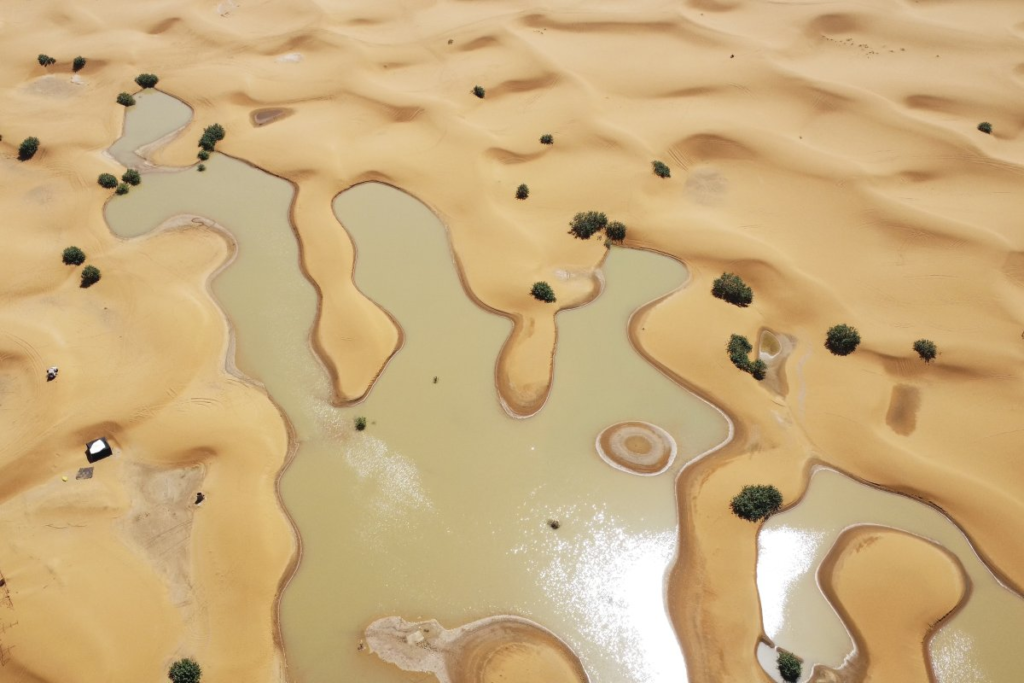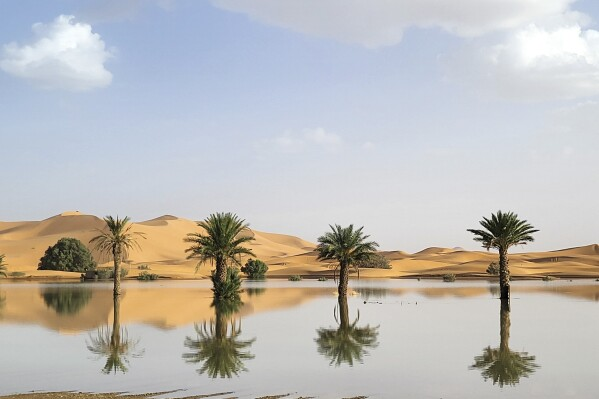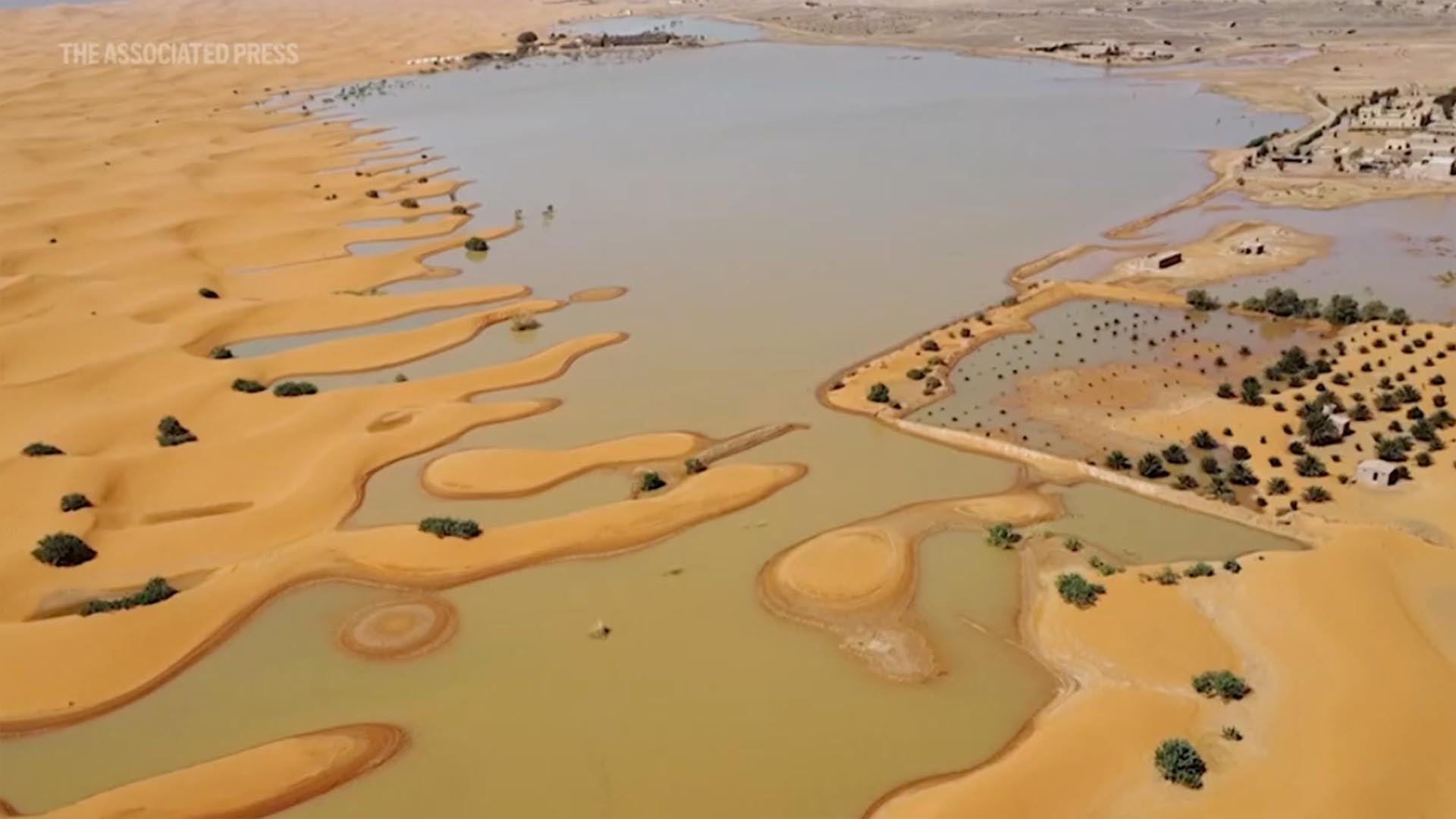Sahara Desert, known for its vast arid expanses and iconic sand dunes, recently witnessed a remarkable natural event. A deluge of rainfall in southeastern Morocco transformed the arid desert landscape into one dotted with blue lagoons and overflowing rivers.
For many regions, this rainfall was a once-in-a-lifetime event, bringing more water than had been seen in decades. The unexpected storm not only stunned the desert communities but also had a profound impact on the region’s fragile ecosystems, water resources, and agriculture.
The Impact of Rare Rainfall in the Sahara Desert
The southeastern region of Morocco, including areas like Tata and Tagounite, is among the driest places on earth. In these parts of the Sahara Desert, rainfall is an anomaly, especially during late summer.
Read : In the Heart of the Barren: Ranking the Top 10 Largest Deserts Worldwide
The average annual precipitation for these areas is less than 250 millimeters (10 inches), and many regions have gone years without significant rainfall.
However, in September, an extratropical storm brought two days of intense rainfall, exceeding yearly averages in just 24 hours. In Tagounite, more than 100 mm (3.9 inches) of rain was recorded within a day, a striking contrast to the usual aridity.
Read : Sahara Desert Turning Green from Arid Yellow on Recent Pic Shared by NASA
This rare deluge led to awe-inspiring scenes, with torrents of water rushing through the Saharan sands, forming lagoons amidst the palm trees and sand dunes.
In areas that had long been parched by drought, the sight of bountiful water flowing through ancient desert landscapes was both shocking and mesmerizing. The local population, used to the dry heat and scarcity of water, was taken aback by the sheer volume of rain. For many, it had been 30 to 50 years since they had seen such a rainfall event.

While the rains brought much-needed relief to the drought-stricken areas, they also posed challenges. The heavy downpour caused widespread flooding, leading to over 20 fatalities in Morocco and Algeria.
Agricultural fields, which had already suffered from years of drought, were further damaged by the flooding, forcing the government to step in with emergency relief funds.
Changing Weather Patterns in the Sahara
Meteorologists described the rainstorm as an extratropical storm, a rare weather phenomenon in this part of the world. The storm’s arrival in the Sahara Desert is indicative of shifting weather patterns.
According to experts, the air in the region is now retaining more moisture due to climate change, which has increased the frequency and intensity of such storms. This means that while the Sahara Desert will continue to experience long periods of drought, there may also be more frequent rainfall events in the future.
The September rainstorm has raised questions about whether such events could change the long-term climate in the Sahara. Historically, the desert has been one of the most inhospitable places on Earth, with temperatures often soaring above 50°C (122°F) and vast areas devoid of life.
However, increased moisture in the air, combined with more frequent storms, could lead to more vegetation and even the reemergence of seasonal lakes and rivers.
One striking example of this is Lake Iriqui, a lakebed that had been dry for 50 years but filled with water after the September rains. Satellite imagery from NASA showed water rushing into the lake, transforming a barren landscape into a shimmering body of water. The reappearance of such natural water bodies could have significant implications for the region’s ecosystems and local communities.

While it’s unclear how long the effects of the recent rainfall will last, experts believe that the storm has replenished the region’s groundwater reserves, which are critical for sustaining desert communities. The rain also refilled dammed reservoirs at record rates, providing a temporary respite from the water shortages that have plagued the region in recent years.
Life in the Desert: Challenges and Opportunities
The Sahara Desert is not only the largest hot desert in the world, but it is also home to a diverse range of plants, animals, and human communities that have adapted to its harsh conditions. The recent rains have provided an unexpected boost to the desert’s ecosystems, replenishing water sources that had been on the verge of depletion.
In desert oases, where water is scarce and essential for survival, the sudden influx of water has had both positive and negative effects. On one hand, the rainfall has nourished date palms, desert flora, and small crops, providing temporary relief to farmers who have struggled to cultivate their lands during years of drought.
On the other hand, the intensity of the storm damaged some of the year’s harvest, leaving farmers in need of government support to recover their losses.
The desert communities, many of which rely on tourism as a key source of income, also faced challenges as roads became impassable and floodwaters damaged infrastructure.
However, the unusual sight of water flowing through the desert has drawn tourists eager to witness the rare phenomenon. Four-wheel-drive vehicles navigated through the flooded landscapes, offering visitors a unique perspective of the transformed desert.
The longer-term impact of the rainfall on desert life remains uncertain. While the rains have temporarily revived some ecosystems and water sources, the Sahara’s harsh climate will likely continue to dominate the region.
Groundwater aquifers, which are critical for supplying water to desert communities, have likely been replenished, but it’s unclear how much of the recent rainfall will translate into sustained water availability in the coming months and years.

The Moroccan government has been quick to respond to the crisis, allocating emergency relief funds to the hardest-hit areas and providing support to farmers and communities affected by the flooding. The government’s focus is now on recovery, ensuring that the rains’ benefits are maximized while mitigating the damage caused by the storm.
The recent rainfall in the Sahara Desert has brought much-needed water to some of the driest regions in the world, providing a temporary respite from years of drought. The deluge transformed the desert landscape, filling dry lakebeds and nourishing oases with more water than had been seen in decades.
While the rainfall has had both positive and negative effects on the region’s ecosystems and communities, it also highlights the changing weather patterns in the Sahara Desert.
As climate change continues to impact the region, the Sahara may experience more frequent rainfall events in the future, offering both challenges and opportunities for those who call the desert home.
The Moroccan government’s swift response to the crisis, combined with the resilience of desert communities, will be critical in ensuring that the region can recover and adapt to these new environmental conditions.

